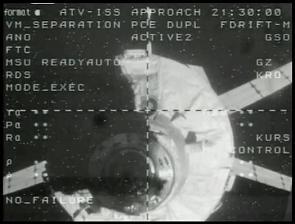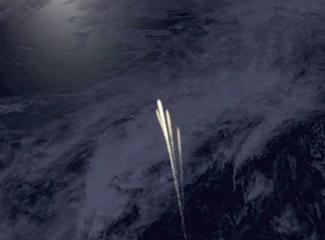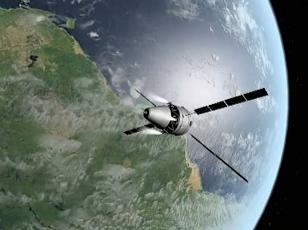We covered the ATV Jules Verne mission in a previous post (Jules Verne close to the End of its Space Journey) and mentioned that the typical ATV mission ends with a destructive re-entry above the Pacific Ocean. We come back with this post to present the conclusion of the ATV mission.
The ATV separated from the International Space Station (ISS) on September 5, 2008, filled with more than 2 tonnes of waste. The ATV undocked from the aft port of the Zvezda Service Module and it was placed in a parking orbit for three weeks. While being parked, a series of tests of the guidance and control systems were performed.
By carrying out re-phasing maneuvers, the ATV positioned itself to a predefined position behind and underneath the ISS. In this way, the crews from the ISS and from two specially equipped observation planes in the skies of the South Pacific were able to view and to record the re-entry.
The re-entry was initially modeled on computer in order to anticipate the trajectory and the location of the area where the breakout fragments of the spacecraft will fall. The observations helped determine if the re-entry matched the computer modeling.
As planned, the first ATV mission concluded on September 29, 2008, when two engine burns de-orbited the spacecraft. ESA scheduled the re-entry on this date because the lighting conditions were appropriate for an imagery experiment and the breakup happened at approximately 75 km above the waters of the Pacific Ocean. The remaining fragments fell into the Pacific some 12 minutes later.
This first mission proved the logistical value of the ATV. The delivery of 6 tonnes of cargo to the ISS, the automatic rendezvous and docking capabilities, the attitude control maneuvers performed, they all show how far the European space capabilities have developed.
ESA engineers are already working on the next two ATV spacecrafts. The next ATV mission is scheduled for 2010 and there are many proposals to adapt the ATV to other types of missions.
One important variation of the typical ATV mission is the Large Cargo Return (LCR). The LCR configuration will consist of a large cargo capsule capable of bringing back on Earth hundreds of kilograms of cargo and valuable experiment results. LCR would be able to dock to the US side of the ISS that has larger docking ports and would make possible the transfer of complete payload racks.
The video showing the destructive re-entry of Jules Verne is available on the ESA website.













 Subscribe to our RSS feed
Subscribe to our RSS feed











There are no comments.
Add A Comment